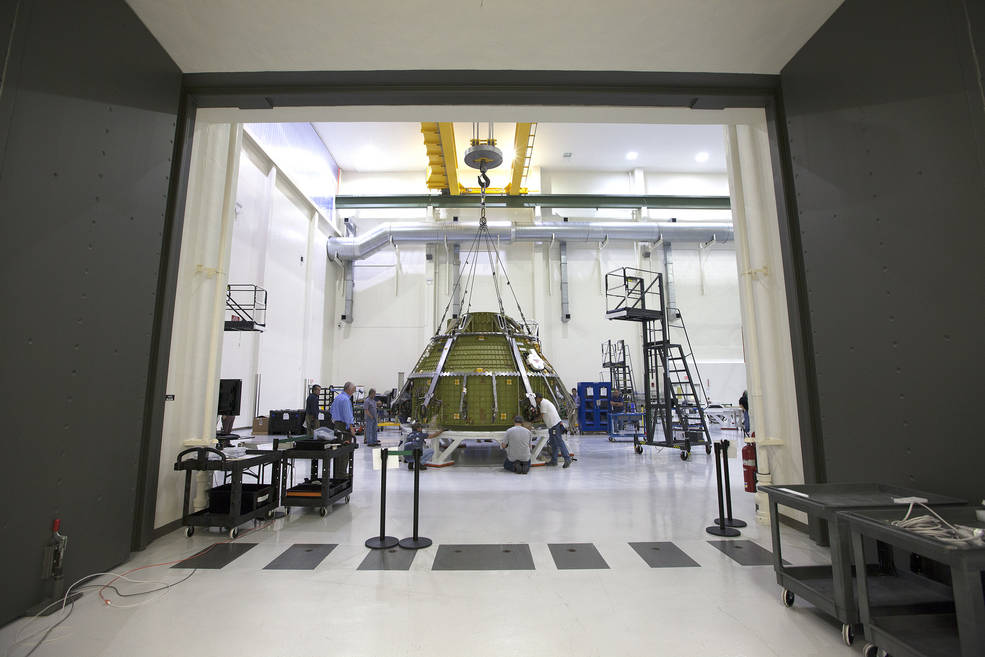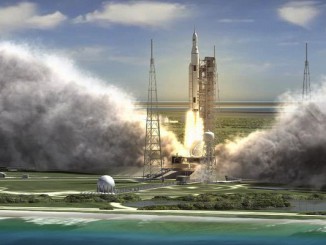
The skeleton of NASA’s next Orion capsule, set for launch in late 2018 on a test flight to lunar orbit without astronauts, has passed a pressurization test at the Kennedy Space Center in Florida.
The next step will be outfitting the capsule with fuel tanks, propellant lines, command and control computers, and other systems in the run-up to its liftoff on a nearly three-week mission to lunar orbit and back to Earth.
Exploration Mission-1, or EM-1, will blast off from launch pad 39B at the Kennedy Space Center aboard the Space Launch System, NASA’s future heavy-lift rocket to take humans into deep space.
Orion’s first crewed mission to deep space could follow as soon as 2021.
The olive-green pressure shell of the Orion spacecraft assigned to fly on EM-1 arrived at the Florida spaceport Feb. 1 for two-and-a-half years of assembly and testing inside the space center’s Neil Armstrong Operations and Checkout Building.
Technicians welded the basic structure of the capsule at NASA’s Michoud Assembly Facility in New Orleans before its delivery to Florida for final assembly.
The first step in Orion’s EM-1 campaign was the proof pressure test, in which the capsule was pressurized to check the workmanship of the crew module’s welds and the craft’s response to the stresses of pressurization, according to NASA.
Engineers from Lockheed Martin, the Orion program’s prime contractor, attached hundreds of strain gauges throughout the interior and exterior of the spacecraft, NASA said in a status update. Lockheed Martin completed the proof pressure test over a two-day period.
“We are very pleased with the performance of the spacecraft during proof pressure testing,” said Scott Wilson, NASA manager of production operations for the Orion program. “The successful completion of this test represents another major step forward in our march toward completing the EM-1 spacecraft, and ultimately, our crewed missions to deep space.”
Technicians will begin installing components inside and outside the Orion crew module in the coming months.
“As we get into the summer, we move into the clean room area of the O&C (Operations and Checkout Building), where we do the installation and welding of propellant lines, coolant lines and those systems, and then in the fall we install all of the avionics, flight computers and processing units,” said Mike Hawes, Lockheed Martin’s Orion program manager.
Spaceflight Now members can read a transcript of our full interview with Mike Hawes. Become a member today and support our coverage.
The first full power-up of the Orion crew module for functional tests is scheduled for early 2017, Hawes said.
The EM-1 campaign is the second time an Orion spacecraft has been prepared for flight at the Kennedy Space Center, and Hawes said the experience should speed up processing this time.
The proof pressure test on the Orion crew module for Exploration Flight Test-1, which launched on a four-hour test flight in Earth orbit in 2014, caused cracks in the spacecraft’s structure. No such problems were reported in the recent test on the second space-worthy Orion.
“We have made some modifications to the tooling. We actually have made some modifications to the structure itself that facilitates some of the operations here in Florida, and we have revamped our clean room operation,” Hawes said. “We had a considerable issue last time with contamination that we did not expect, so we have revamped the clean room that establishes a very different flow pattern, which we expect to work much better in that area. I think the things that we learned will actually help us accomplish things a bit faster than we did for EFT-1.”
He said engineers also learned lessons on how to manufacture the Orion crew module.
“We’re down to just seven welds,” Hawes said in an interview with Spaceflight Now. “We learned a lot about manufacturing, particularly on the cone panels. We were able to manufacture the barrel as a whole single element, and the aft bulkhead piece is a single element now. So we dramatically reduced the weight and dramatically reduced the number of welds.”
The Orion team is on pace to have the crew module ready for flight by the end of September 2018, two months before NASA’s official target date for the EM-1 mission, according to Hawes.
He said the schedule for September 2018 is “very tight” but added that schedulers can ramp up to two or three shifts per day when possible.
“There are certain blocks of time that we know we have more schedule flexibility here than others, and as we can use that to our advantage I think it will give us the confidence to be able to hold schedule,” Hawes said. “The other aspects of the mission, I can’t really say.”

The flight in 2018 will mark the first flight of a European-built service module with the Orion spacecraft.
Integration of the service module’s flight model has begun at an Airbus Defense and Space facility in Bremen, Germany. The element, which did not fly on Orion’s EFT-1 test flight in 2014, will provide propulsion, power, thermal control, water and air to the Orion spacecraft.
In the meantime, a structural test article of the service module is undergoing testing at NASA’s Plum Brook Station in Ohio to ensure the craft can withstand the noise and vibration of launch.
The flight version of the service module is scheduled for delivery to the Kennedy Space Center from Europe in early 2017.
The two sections of the Orion spacecraft, the crew and service modules, will be mated in Florida and transported to Plum Brook for a second round of tests — this time with flight hardware — in late 2017.
The spacecraft will return to the Kennedy Space Center by the end of 2017 to begin final launch preparations, such as fueling and integration with its aerodynamic shroud and launch abort system.
Then it will be hoisted atop the huge Space Launch System inside the spaceport’s iconic Vehicle Assembly Building before rollout to launch pad 39B.
Email the author.
Follow Stephen Clark on Twitter: @StephenClark1.



